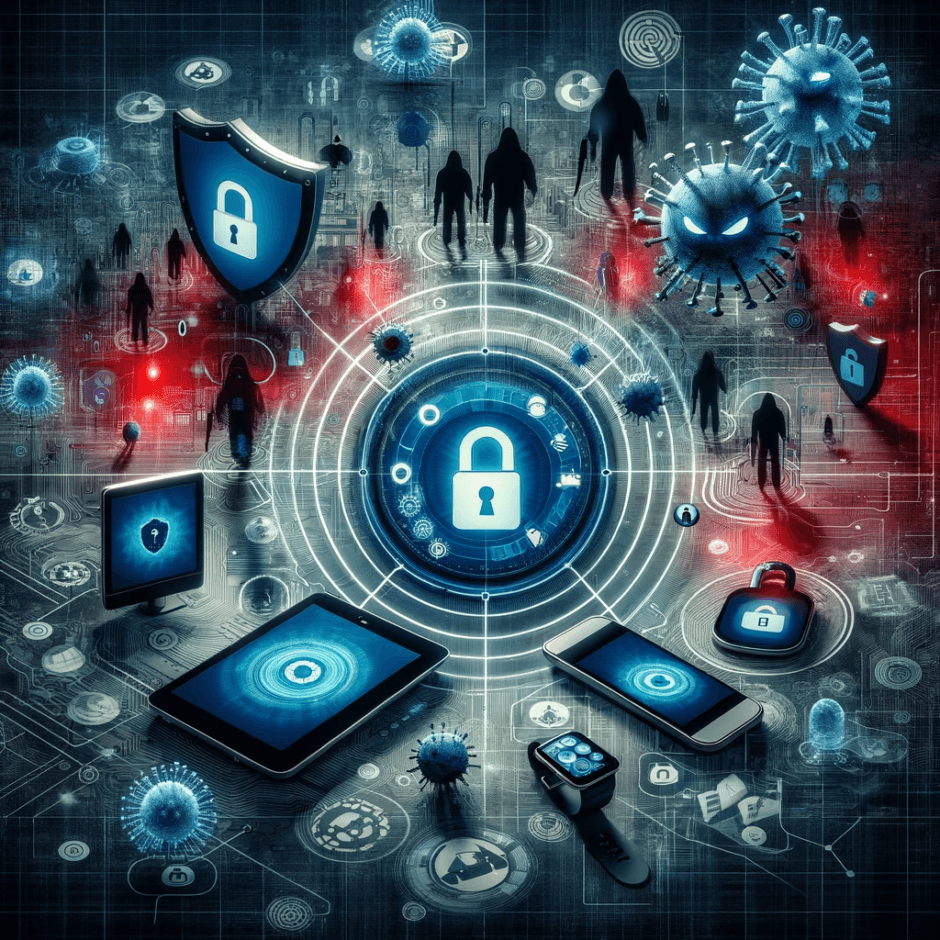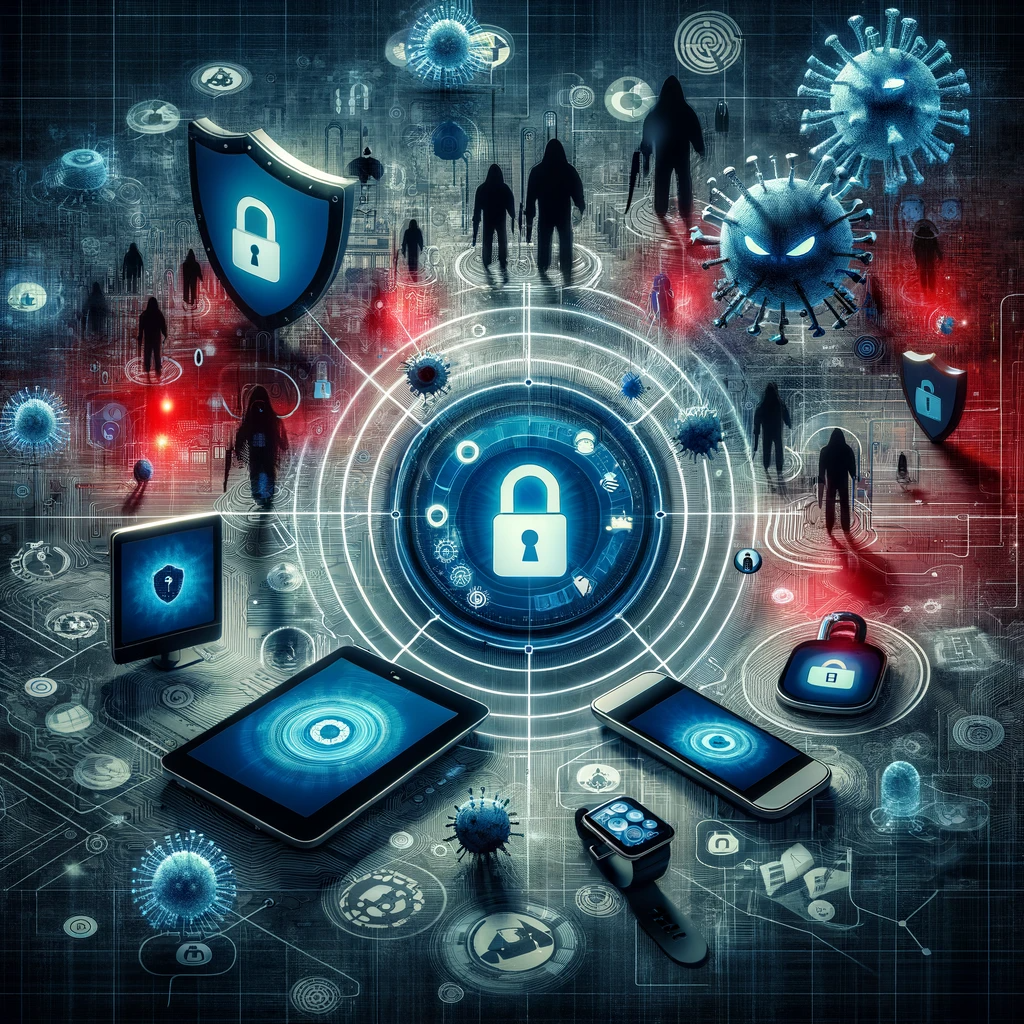Navigating the Risks: Unpacking Cybersecurity for Smart Devices
Defining the Internet of Things (IoT) and its impact on daily life

The Internet of Things (IoT) represents a transformative shift in how we interact with technology.
It refers to the network of physical objects, from household appliances to vehicles, embedded with sensors, software, and other technologies for the purpose of connecting and exchanging data with other devices and systems over the Internet.
This connectivity brings unparalleled convenience, allowing remote control, monitoring, and automation of numerous daily tasks. However, it also integrates technology into the most intimate aspects of our lives, underscoring the importance of understanding and managing the risks associated with IoT.
Understanding the critical role of data privacy in smart device usage Data privacy is a cornerstone of secure smart device usage.
As these devices collect, transmit, and store vast amounts of personal information, they become prime targets for cyber-attacks.
This information, ranging from mundane daily routines to sensitive personal data, can be exploited for malicious purposes if not properly secured.
The increasing reliance on smart devices underscores the need for robust privacy protections and highlights the responsibility of both manufacturers and users in safeguarding this data.
Exploring common vulnerabilities in smart devices and their implications
Smart devices, despite their advanced technology, are not immune to vulnerabilities.
These can range from weak passwords and unsecured network connections to flaws in software and firmware.
Hackers can exploit these vulnerabilities to gain unauthorized access, steal personal data, or even take control of the devices.
The implications are significant, not just in terms of personal privacy but also for broader security concerns, as compromised devices can be used in larger network attacks or as gateways to access other connected systems.
The risks of neglecting cybersecurity—case studies highlighting the consequences
Neglecting cybersecurity can have severe consequences, as illustrated by numerous case studies.
For instance, the infamous Mirai botnet attack in 2016 used thousands of infected IoT devices to launch massive distributed denial-of-service (DDoS) attacks, disrupting internet services globally.
Similarly, smart home devices have been hacked to spy on users, and vulnerabilities in medical devices like pacemakers have raised life-threatening concerns.
These cases highlight the dire need for robust cybersecurity measures in the realm of smart devices.
Guardians Of The Digital Realm: Cybersecurity Experts and Institutions
Highlighting the work of cybersecurity experts and ethical hackers in protecting smart device users
Cybersecurity experts and ethical hackers play a pivotal role in safeguarding the IoT ecosystem. These professionals tirelessly work to identify and rectify vulnerabilities in smart devices before they can be exploited by malicious hackers.
Ethical hackers, in particular, use their skills to simulate cyber-attacks, uncovering weak points in security systems. Their work not only protects users but also contributes to the overall improvement of cybersecurity standards and practices in the industry.
The contributions of government cybersecurity agencies and academic institutions to IoT security
Government cybersecurity agencies and academic institutions are key players in enhancing IoT security.
Agencies like the U.S. Cybersecurity and Infrastructure Security Agency (CISA) develop guidelines, provide resources, and coordinate responses to cyber threats, playing a crucial role in national security.
Meanwhile, academic institutions contribute through cutting-edge research, developing new security technologies and strategies.
Their collaborative efforts with the industry help in setting high security standards and preparing the next generation of cybersecurity professionals.
The role of standard-setting bodies, like ISO, in ensuring device security and data privacy
Standard-setting bodies such as the International Organization for Standardization (ISO) are vital in establishing global cybersecurity standards. By developing and promoting international standards, these organizations ensure a baseline level of security and privacy across devices and systems.
This is crucial for interoperability and trust in the IoT ecosystem. Standards like ISO/IEC 27001 provide a framework for managing information security, guiding manufacturers and service providers in implementing comprehensive security measures.
These standards not only help in mitigating risks but also foster consumer confidence in smart device technologies.
Why collaboration among tech hubs and universities is crucial for advancing cybersecurity
Collaboration between tech hubs and universities is essential for advancing cybersecurity in the IoT domain.
Tech hubs, with their concentration of startups and established tech firms, are innovation hotspots, continuously pushing the boundaries of what’s possible in smart device technology.
Universities, on the other hand, are breeding grounds for new ideas and research.
When these two collaborate, there’s a synergy that accelerates the development of more robust and sophisticated cybersecurity solutions, combining practical industry insights with academic expertise.
Choosing Your Shield: Tools and Solutions in Smart Device Security
A comprehensive guide to antivirus, firewalls, and VPNs for smart device security
In the realm of smart device security, tools like antivirus software, firewalls, and VPNs (Virtual Private Networks) are fundamental.
Antivirus software provides a layer of defense against malware and other malicious software.
Firewalls act as gatekeepers, monitoring and controlling incoming and outgoing network traffic based on predetermined security rules.
VPNs enhance security and privacy by creating a private network from a public internet connection, masking users’ IP addresses and encrypting data transfers. Understanding and utilizing these tools is critical for maintaining the security and integrity of smart devices.
Understanding the importance of regular security patches and update systems
Regular security patches and updates are crucial for maintaining the integrity of smart devices. Manufacturers often release updates to fix vulnerabilities, add new features, or improve existing functionalities.
Neglecting these updates leaves devices susceptible to known security threats. Automated update systems can help ensure that devices are always running the latest software, thereby minimizing the risk of cyberattacks.
Users should prioritize these updates and be proactive in checking for and installing them to safeguard their devices.
Security analysis tools and smart device management software—do you need them?
Security analysis tools and smart device management software are becoming increasingly important as the number of connected devices in our homes and workplaces grows.
Security analysis tools help in identifying vulnerabilities and assessing the security posture of a network. Smart device management software, on the other hand, allows users to control and monitor all connected devices from a centralized platform, simplifying the management of security settings and updates.
Both types of tools are essential in a comprehensive cybersecurity strategy for IoT environments.
How cybersecurity software companies innovate to stay ahead of cyber threats
Cybersecurity software companies are in a constant race against evolving cyber threats.
They innovate by developing more sophisticated algorithms, incorporating artificial intelligence and machine learning to detect and respond to threats in real time.
They also focus on user-friendly designs, ensuring that security software is accessible and manageable for all users, regardless of their technical expertise.
By continuously evolving their products and services, these companies play a critical role in safeguarding the ever-expanding universe of smart devices.
The Competitive Edge: Smart Device Manufacturers and Security Features
How Apple, Samsung, and other manufacturers incorporate encryption and network security
Leading smart device manufacturers like Apple and Samsung have placed a strong emphasis on incorporating advanced encryption and network security features into their products.
Encryption ensures that data, whether at rest or in transit, is protected from unauthorized access.
Network security features, including secure Wi-Fi connections and the ability to detect and prevent intrusion attempts, are integral to protecting devices from external threats.
These companies continuously update their security protocols to address new vulnerabilities, demonstrating their commitment to user safety.
Comparing smart device security features to make an informed choice as a consumer
As a consumer, it’s important to compare the security features of different smart devices.
This includes evaluating the strength of encryption, the robustness of network security measures, and the frequency and reliability of security updates provided by the manufacturer.
Additionally, understanding how these devices manage data privacy and user consent for data collection can be crucial.
Making an informed choice involves balancing the desired features and functionalities with the level of security and privacy offered.
The impact of competitor innovations and alternative security solutions on market dynamics
Competitor innovations and alternative security solutions significantly impact market dynamics in the smart device industry.
When a company introduces a novel security feature, it sets a new standard, compelling others to follow suit or risk losing market share.
This competitive environment drives rapid advancements in technology and offers consumers a wider range of secure options.
Furthermore, the emergence of third-party security solutions provides additional layers of protection and choice, contributing to a more robust and diverse cybersecurity ecosystem.
Privacy advocates vs. smart device security—understanding the concerns and demands
The debate between privacy advocates and smart device security is a critical one.
Privacy advocates argue for stringent data protection measures and transparency in how data is collected, used, and shared.
They raise concerns about the potential for surveillance and misuse of personal information.
On the other hand, enhancing smart device security often requires collecting and analyzing data to identify and respond to threats.
Balancing these two aspects—privacy and security—is a delicate task, necessitating a nuanced approach that respects user privacy while ensuring robust security.
The Future of Cybersecurity: Preparing for What Lies Ahead
Predicting the integration of AI in cybersecurity for evolving smart device threats
The integration of Artificial Intelligence (AI) in cybersecurity is set to revolutionize how we protect smart devices against evolving threats.
AI’s ability to analyze vast datasets rapidly enables the identification of patterns and anomalies that might indicate a security breach.
This proactive approach to security, where threats are identified and mitigated before they cause harm, is particularly crucial in the fast-paced and ever-changing landscape of smart device technology.
AI’s role in the future of cybersecurity is not just about defense; it’s about staying one step ahead of cybercriminals.
Addressing the growing demand for cybersecurity expertise and training programs
As the complexity and number of cyber threats increase, so does the demand for skilled cybersecurity professionals.
This demand highlights the need for comprehensive training programs and educational pathways that can produce experts equipped to tackle these challenges.
Universities, vocational schools, and online courses are all ramping up efforts to provide education in this field.
Moreover, continuous learning and staying abreast of the latest developments will be crucial for professionals in this ever-evolving landscape.
Anticipating regulatory changes and the need for enhanced smart device security measures
Regulatory changes are anticipated in response to the growing concerns over smart device security.
Governments worldwide are likely to implement stricter regulations to ensure manufacturers prioritize security in their devices.
These regulations may include mandatory security standards, regular audits, and penalties for non-compliance.
Such measures will not only protect consumers but also encourage innovation in cybersecurity, leading to more secure and trustworthy smart device ecosystems.
Emerging cybersecurity technologies and the promise of quantum encryption
The future of cybersecurity also lies in emerging technologies like quantum encryption.
Quantum encryption leverages the principles of quantum mechanics to create theoretically unbreakable encryption.
This technology is particularly promising for securing data transmission in an era where traditional encryption methods may falter against the advancing computational power of cyber attackers.
As we move towards more interconnected and smart device-reliant societies, the adoption of such cutting-edge technologies will be paramount in safeguarding our digital lives.

